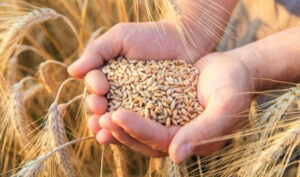
The Ministry of Agrarian Policy and Food of Ukraine has updated its forecast for gross production of grain and oilseeds. This year Ukrainian agrarians can harvest about 56.4 million tons of grains, as well as 20.3 million tons of oilseeds, the ministry’s press service reported.
“At the beginning of spring 2023, the total gross harvest for the current year was projected at 63.5 million tons, which was 13% less in relation to the indicator of 2022. In June, after harvest began, the forecast was raised to 68 million tons, which was 7% less than the 2022 figure. Now, thanks to favorable weather conditions, there is every reason for another change in the forecast in a positive direction to 76.7 million tons, which is 5% more than the figure of 2022,” – noted on the website of the Ministry.
According to the report, despite the fact that the total area of sown spring and winter cereals this year was less by 980 thousand hectares than last year and amounted to 10,895 thousand hectares, weather conditions contributed to almost record yields of grain crops (up to 51.8 c/ha), which allows to significantly increase the volume of crop production.
According to preliminary estimates of the Ministry of Agrarian Policy, in 2023 agrarians will be able to harvest grain in the following volumes: wheat – 20.9 million tons, barley – 5.8 million tons and corn – 28.1 million tons.
Gross production of oilseeds, according to the Ministry’s forecasts, will reach 20.3 million tons, in particular, sunflower – 12 million tons, rapeseed – 4 million tons, soybeans – 4.2 million tons.
Agrarians will harvest 13.7 million tons of sugar beet this year.

Ukraine has already harvested 12.5 million tons of wheat with record yields, but due to weather conditions 60% of the crop will be sold as fodder, which is twice as much as last year’s figure, according to the analytical cooperative “Pusk”, established within the framework of the All-Ukrainian Agrarian Rada (VAR).
“The key problem of the new harvest was its low quality: due to weather conditions, the grain has a low protein content. Most exporting countries also have problems with the quality of grain,” analysts said.
According to their information, the volume of feed grain in the season-2023 may amount to 60% of the new harvest. In previous years, this figure was at the level of 30%, and the remaining 70% was food grain.
Ukraine will get no more than 40% of high-protein wheat in 2023, which will affect prices.
“The spread between fodder and high-protein wheat is already $15-18/ton, in the future it may exceed $20/ton,” experts noted.
The current season will be problematic with the supply of food grain worldwide, stated the WAR and added that a lot of feed grain will be produced by France, Germany and the Russian Federation, which are experiencing problems with grain quality.
“Those who have high-protein wheat are selling to Lithuania, to Germany, and at small ports the supply is low. If last season the markets were surplus, traders dictated prices, now we are moving to a deficit model. Farmers are not taking wheat to the ports, and prices will rise,” the analysts explained.
They reported that prices in Danube ports on the basis of CPT are $170-175/tonne, by the end of the week they are expected at $180/tonne, and by the end of August may exceed $200/tonne.
“World demand is just starting to grow, there will be news of quality problems in other regions as well,” predicted the CAP.

Agrarians of all regions of Ukraine have harvested early grain and leguminous crops on the area of 3782 thousand hectares, having threshed 16 million 574 thousand tons of grain at a yield of 44 c/ha, the press service of the Ministry of Agrarian Policy and Food reported.
According to the report, in terms of threshing rates the agrarians of Mykolaiv and Odessa regions are leading, which threshed 1772.2 thousand tons and 2.009 million tons of grain, respectively. In these regions grain has been threshed on 82% and 64% of areas.
To date, Ukraine has harvested barley on 939 thousand hectares, which is 66% of the planned, of which threshed 3.755 million tons; wheat from 2.698 million hectares (60%) harvested 12.513 million tons; peas from 125.3 thousand hectares (87%) received 306.4 thousand tons.
In addition, on the area of 1182.3 thousand hectares (86% of the planned area) harvested 3319.8 thousand tons of winter rape.
The Ministry of Agrarian Policy changes weekly information about the yield of harvested crops and indicates its growth. Thus, for barley this week it amounted to 40 c/ha, and a week earlier 39.4%, wheat from 44.4 c/ha reached 46.4 c/ha, winter rape from 26.8 c/ha – to 28.1 c/ha. Only peas slightly “gave up positions” from 24.7 c/ha to 24.5 c/ha.
According to the report, agrarians of nine regions have completed pea harvesting. In Dnipropetrovsk region they have started harvesting buckwheat.
As reported, winter wheat sowing this season amounted to 4166 thousand hectares (-834 thousand hectares to the previous season), winter barley – 536 thousand hectares (-255 thousand hectares), rape – 1374 thousand hectares (+110 thousand hectares).

Ukraine in the 2022-2023 marketing year (MY) harvested 70 million tons of grain and managed to export two-thirds of the harvest planned for export even taking into account the record high transitional residues, Minister of Agrarian Policy and Food Mykola Solskiy said on air of the marathon “United News”.
“Last year we harvested only about 70 million tons. All that we planned to take out, we took out. This is about two-thirds. We have transitional residues by the beginning of July – several million tons. If we compare it with the transitional residues last year, it is several times less – it was 22 million tons then. This is due to the fact that we were not traveling for a couple of months and had a huge harvest in 2021,” he explained.
Solsky recalled that in May in the Ministry of Agrarian Policy predicted that this year’s grain harvest will be 10% lower than last year. However, now the expectations have changed and the Ministry expects that the grain harvest will be less by about 6% due to favorable weather conditions.
“Agrarians have decided to sow corn not in the same volume (as before – IF-U), but to sow more sunflower and soybeans. It can be the same income in money, but the logistics costs are less and it is necessary to deal with it less, because conditionally the yield of corn per hectare is two to three times higher than that of soybeans and sunflowers,” the minister explained.
Solsky noted that farmers are not accustomed to difficulties and expressed confidence that Ukrainian farmers will cope with the challenges that constantly arise before them.
The minister called the main problem of Ukrainian farmers not difficulties with the realization of the produced products, but with the price for them.
“In the coming months, the work of everyone related to the state authorities will be related to the fact that they (agrarians – IF-U) will be able to sell expensively. This has to do with reducing logistics costs, with expanding opportunities, where it can go, to which countries to sell,” he summarized.

Transit of Ukrainian grain through Poland is steadily growing: if in February it was 114 thousand tons, in June it exceeded 260 thousand tons, Polish Minister of Agriculture and Rural Development Robert Telusz said after online talks on Wednesday with Ukrainian Minister of Agrarian Policy Mykola Solskiy.
“This is very good news for agrarians, because grain from Ukraine does not enter the Polish market,” the Polish minister was quoted as saying in a tweet and on the ministry’s website.
At the same time, he said he saw a chance for the European Commission to extend the decision to ban Ukrainian grain exports to Poland after September 15, blaming both those in power in the EU and the Polish opposition for trying to destabilize Poland.
“It is in our interest to protect the Polish farmer. That is why a clear statement was made by Prime Minister Morawiecki that Ukrainian grain will not enter Poland after September 15,” Telusz reiterated.
According to him, the Polish side wants the so-called “solidarity corridors” to work effectively, which would allow for efficient transportation of Ukrainian goods without harming the Polish agricultural sector.
A press release from the Polish ministry indicates that to this end Telusz proposed measures to facilitate the transit of Ukrainian grain to seaports in various EU countries, in which Solsky was interested, but no other details are available and the Ukrainian ministry has not officially commented on the talks.
The Polish Ministry of Agriculture said that the Ukrainian side will also present a draft of detailed solutions in the near future. “He (Solsky – IF-U) explained that Russian missile strikes on Ukraine’s port infrastructure have put Ukrainian exporters in a very difficult situation. Now they will have to organize grain exports via other routes,” the release said.
Telush informed about ongoing negotiations with Lithuania and Latvia on the use of their ports for grain exports from Ukraine. “These negotiations are going in the right direction,” the minister added.
According to him, Poland has managed to significantly increase grain exports through its four main ports this year. In particular, if in January it amounted to 299 thousand tons, in February – 539 thousand tons, in March – 628 thousand tons, in April – 704 thousand tons, in May – 882 thousand tons, and in June – almost 940 thousand tons.
Poland exported more than 4.5 million tons of crops in 4 months of this year, stated Telusz.
It is noted that the ministers also raised the issue of access of Polish poultry products and eggs to the Ukrainian market, and currently the veterinary services of both countries are working intensively to resolve this issue.
The Polish Ministry of Agriculture pointed out that Ukraine is an important partner of Poland in agri-food trade. In 2022, an increase in agricultural exports to the Ukrainian market by 16% to $945.3 million was recorded. The main export items were: cheese and cottage cheese, products used for animal feed, and coffee. In April 2023, exports of agricultural products to the Ukrainian market increased by more than 35% compared to the same period in 2022, the release added.

The rental rate of grain and flour wagons of conditional type 972, owned by JSC “Ukrzaliznytsia”, from August 1 will increase by 100 UAH compared to July and will amount to 400 UAH/day (excluding VAT), according to the company’s website.
According to the report, the daily fee for the use of Ukrzaliznytsia’s mineral wagons for the transportation of grain cargoes next month will decrease from UAH 1,500 in July to UAH 1,300, and in the case of the use of cement wagons for these purposes will increase from UAH 500/day to UAH 600/day.
The rate of payment for the use of tank cars for transportation of food products in August will decrease from 1700 to 1500 UAH/day.
The gondola car rental rate will increase to 1400 UAH/day next month (1300 UAH/day in July).